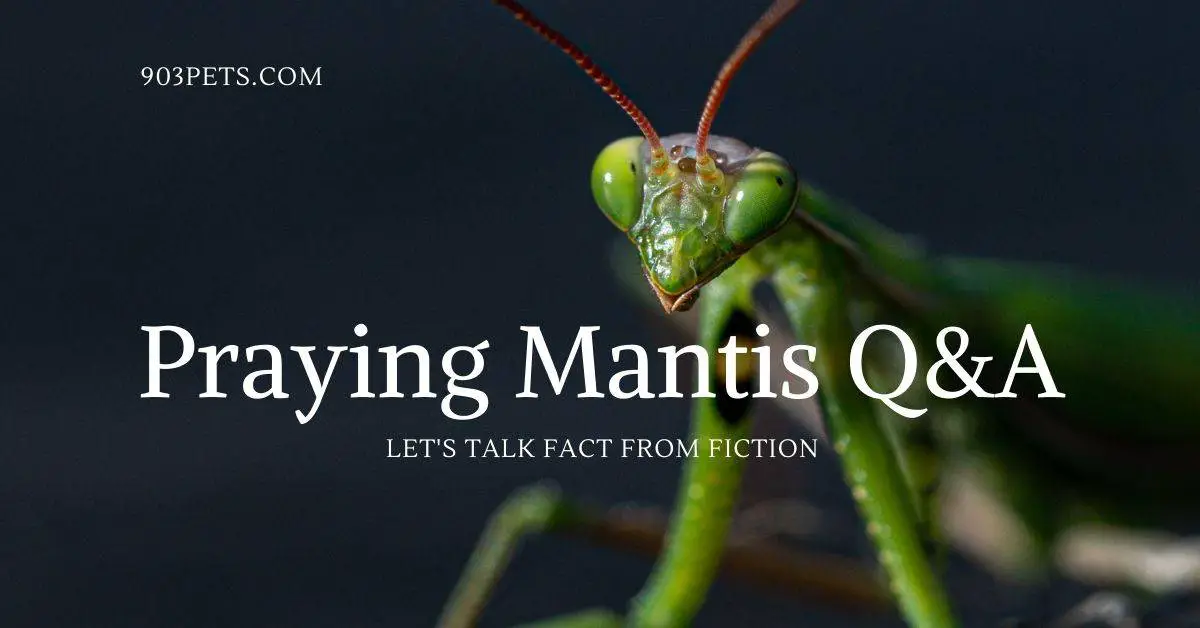Praying Mantis Q&A | Are They Dangerous?
Praying mantis are fascinating animals. However, when you search the internet for information, you get a bunch of myths and misinformation.
We’ve taken the most common questions and myths and provided quick, factual answers that will help you know fact from fiction.
Let’s look at these magnificent insects.

Do Praying Mantis Bite?
Yes, a praying mantis can bite. But, they use mandibles, not teeth to do the work.
That may sound horrifying, but unless you are an insect, you’re not in any significant danger.
Praying mantids are prey insects, meaning that they are avid hunters. A mantid has strong mouthparts that can cut flesh called mandibles. However, with a praying mantis as a pet, they rarely bite except when they mistake a finger for food.
In fact, when a praying mantis attacks it’s prey, it doesn’t start by biting. The first step is for it launch it’s spiky fore-legs to grab they prey before bringing it to the mandibles to eat it.
That blindingly fast grab by the spiky fore-legs is what most people are scared of and falsely call a bite.
Generally speaking, native praying mantis species in North America are smaller and do not cause significant injury if they grab you.
There are some larger species outside of North America that can eat the smallest bird or rodent but thankfully pose no risk of consuming a human. We’ll talk about them a little later.
Can you imagine a giant dinosaur praying mantis? Now that would be scary!
Do Praying Mantis Eat Ladybugs?
Praying Mantids are not discerning in what they eat and yes, they will eat ladybugs. They are generalists and will eat any insects they come across.
Unfortunately, that means ladybugs, lacewings, and other beneficial insects are on a praying mantis food menu.
Because of this, there are conflicting thoughts about whether praying mantids are good for gardens or not.
Do Praying Mantis Eat Ants?
Yes, Praying mantis will eat ants all day long if they find them tasty. However, don’t count on a praying mantis to remove an ant colony as there are typically way more ants than a mantis will eat.
Of course, not all ants are equal and can turn the tables on a praying mantis.
In Texas, I’ve seen a praying mantis get bested by fire ants in a quick fashion after it was caught on a fire ant mound. Gruesome is the best word I can think of.
Do Praying Mantis Eat Aphids?
Young praying mantids will eat lots of soft-bodied insects, including aphids. This is why gardeners release young mantids, not adults, when trying to control small insect populations.
As praying mantis mature, they stop eating aphids and begin catching larger insect prey. These larger pray can include other beneficial insects as well as pests.
How Long Do Praying Mantis Live?
Praying mantids typically live about 1 year. Some species can live up to 18-20 months in captivity but is fairly rare. It usually takes 4-8 months for a praying mantis to reach maturity.
Do Praying Mantis Kill Hummingbirds?
Absolutely, it can happen! Praying mantis can kill hummingbirds.
While hummingbirds are not a common food source for praying mantids naturally, they can develop a taste for them when discovering hummingbird feeders in backyards.
It is much more common for praying mantis to hunt other insects than a small bird.
Do Praying Mantis Hunt Mice?
While uncommon, praying mantis species that are large enough do occasionally eat mice.
For example, the Chinese Mantis (Tenodera sinensis) can grow to over 6 inches in length which would be plenty large to kill a mouse. Mantids are exceptionally quick and strong, allowing them to overpower a small mouse.
Mantids have incredible arms that are spiny which allows them to hold onto the prey it grabs. A mouse’s fur and skin are easily held by these spines.
Believe it or not, a praying mantis mouth has parts that are strong enough to tear through the thin skin of a mouse.
Do Praying Mantis Have Wings?
Yes, many species and genders of praying mantis develop wings. Most Chinese, Carolina and European mantis species do develop wings. However, the Carolina female wings are very short.
Mantids develop two sets of wings. The outside set of wings are hard and serve to protect the mantis and provide camouflage. The inner set of wings are more translucent and thinner. This inner set are used for flight, or at least an attempt to fly.
It should be noted that their are a few species of mantids that do not grow wings at all, but a less common than those that do.
Do Praying Mantis Fly?
Yes, Chinese and European praying mantises can fly with their large wings. Carolina mantid males can fly short distances, however, the females are unable to fly due to their short wings. Some species of mantids do not develop wings at all and therefore cannot fly.
The flight of a praying mantis is not like a bird. It is clumsy and awkward looking. Praying mantids can only fly short distances. Think of this as more of a very long jump assisted by inefficient wings.
Do Praying Mantis Spit?
No, praying mantises do not spit, although this fictional thought may come from the fact that some species of walking sticks can secrete a nasty “spit” as a defense mechanism.
There is no need to purchase a spittoon for your mantis! 🙂
Do Praying Mantis Change Color?
Yes, some praying mantis species do change colors, but not like a chameleon. When praying mantis change colors, it is usually right after molting and the change takes place gradually over 4-9 days.
The color of a praying mantis is influenced by the light intensity, humidity, and temperature of their habitat.
Do Praying Mantis Drink Water?
Praying mantises do drink water, but not like you may think. You will find a praying mantis drinking water from droplets on plants and leaves. However, it is rare for mantids to drink water from a bowl.
How Long Do Praying Mantis Eggs Take To Hatch?
Praying mantis eggs, ootheca, take 3-6 months to hatch and emerge. When the time arrives, praying mantis eggs need 10-15 days of warmth (75-80F) with a relative humidity above 50%.
If you want to delay the hatching of praying mantis eggs, you can keep them in a refrigerator in a container that allows air to circulate. When you are ready to hatch the praying mantis, take them out of the refrigerator 21-28 days ahead of time.
How Do Praying Mantis Mate?
Praying mantis do mate in order to reproduce. When praying mantids mate, the male approaches the female from the front.
During mating, 13-28% of the time, the female decapitates the male and eats his body for nourishment. Talk about an unbalanced relationship. Yikes!
References
- https://www.smithsonianmag.com/science-nature/how-praying-mantises-can-jump-faster-blink-eye-180954460/
- https://latimesblogs.latimes.com/home_blog/2010/06/master-gardener-uc-extension-beneficial-insects-good-bugs.html
- https://www.gardeningknowhow.com/garden-how-to/beneficial/praying-mantis-egg-sac-info.htm
- https://blogs.scientificamerican.com/artful-amoeba/praying-mantises-catch-and-eat-birds-alive-video/
If you think your pet is ill, call a vet immediately. All health-related questions should be referred to your veterinarian. They can examine your pet, understand its health history, and make well informed recommendations for your pet.
903pets.com Staff





![Do Praying Mantis Make Good Pets? [Pros & Cons] 7 Do Praying Mantis Make Good Pets? [Pros & Cons]](https://cdn-0.903pets.com/ifywhoft/2021/04/Do-Praying-Mantis-Make-Good-Pets-768x402.jpg)

